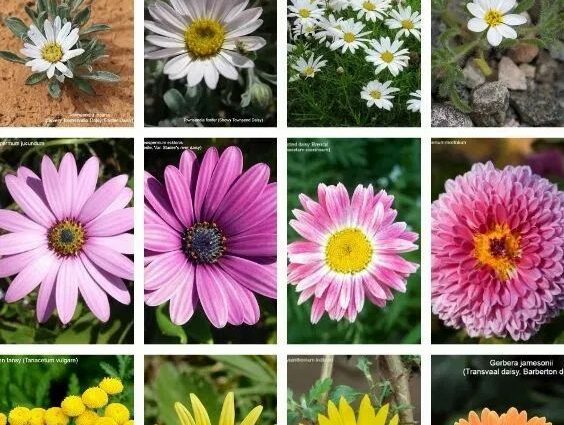Nội dung
Các loại cúc: giống và tên
Today, chamomile is again at the peak of popularity. Thanks to the efforts of breeders, more than 300 varieties of this flower have been created. However, even experienced gardeners often confuse the snow-white beauty with other plants similar to her. Let’s find out what types of daisies exist and consider the most unusual varieties.
Chamomile: the name of popular species
From a botanical point of view, real chamomile (Matricaria) is chamomile, or matricaria. It is used for the manufacture of medicines and cosmetics, but is not very suitable for growing in a flower bed.
The types of daisies are so diverse that they never cease to amaze and delight the eye.
More loved by gardeners all over the world is meadow chamomile, or common daisy. This charming plant has boiling white petals and a bright yellow heart. Today there are many varieties of nivyanik, differing from each other in flower size, shape and terry. In the catalogs you can find a daisy that resembles a chrysanthemum inflorescence.
Miniature chamomile, dimorphoteka, ideal for edging flower beds or growing in rock gardens. True, at night the flower closes its delicate petals, but during the day it shines with all colors from white to orange
In addition to snow-white beauties, “chamomiles” with red, orange or yellow inflorescences often grow in flower beds. These are not daisies, but they are still called daisies for their external resemblance. For example, feverfew, despite the inflorescences of raspberry and pink shades, is popularly called chamomile.
Acroclinums, or pink helipterums, so similar to the nivyanik, look wonderful in the garden. These are annual plants 45-50 cm high with petals ranging from pale pink to white. The core is most often yellow, but it can also be black. There are “daisies” with purple or blue flowers – arkotis and small petals.
Types and varieties of garden chamomile
And yet, despite such a variety of “daisies”, the most favorite among flower growers is the daisy. The classic white cultivar is a perennial plant up to 1 meter high with simple white flowers up to 10 cm in diameter. Blooms profusely all summer. Other varieties may have double or semi-double inflorescences, different heights or foliage shapes.
For curbs and alpine slides, the Little Princess will do. This graceful plant with huge white flowers does not exceed 20 cm in height and is distinguished by long flowering and weather resistance. The undersized daisies include Snowcap and Snow Lady.
Chamomile Bridal Veil (“Bridal Veil”) with a double inflorescence is not inferior in beauty and originality to the best varieties of chrysanthemum
Among medium-sized varieties it is worth paying attention to May Queen (“May Queen”). It is an erect plant with a height of 45-50 cm with bright green leaves and snow-white flowers. The Queen of May is growing rapidly, so it needs to be divided every 2-3 years.
Among tall plants, the Russian variety “Pobeditel” stands out. This robust and abundantly flowering plant up to 120 cm in height is very resistant to rain and wind and does not require a garter. Huge flowers 13-15 cm in diameter are very decorative. The variety is not affected by diseases and pests; it can grow in one place for more than 10 years.
This beautiful and unpretentious plant should be in every garden. Little suns grow and reproduce beautifully, which means they will delight the eye for many years.










